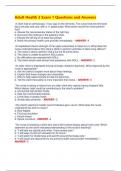Exam (elaborations)
Adult Health 2 Exam 1 Questions and Answers
- Course
- Institution
Adult Health 2 Exam 1 Questions and Answers A client had an arthroscopy 1 hour ago on the left knee. The nurse finds the left lower leg to be pale and cool, with a 1+ pedal pulse. What action would the nurse perform first? a. Assess the neurovascular status of the right leg. b. Document the ...
[Show more]



